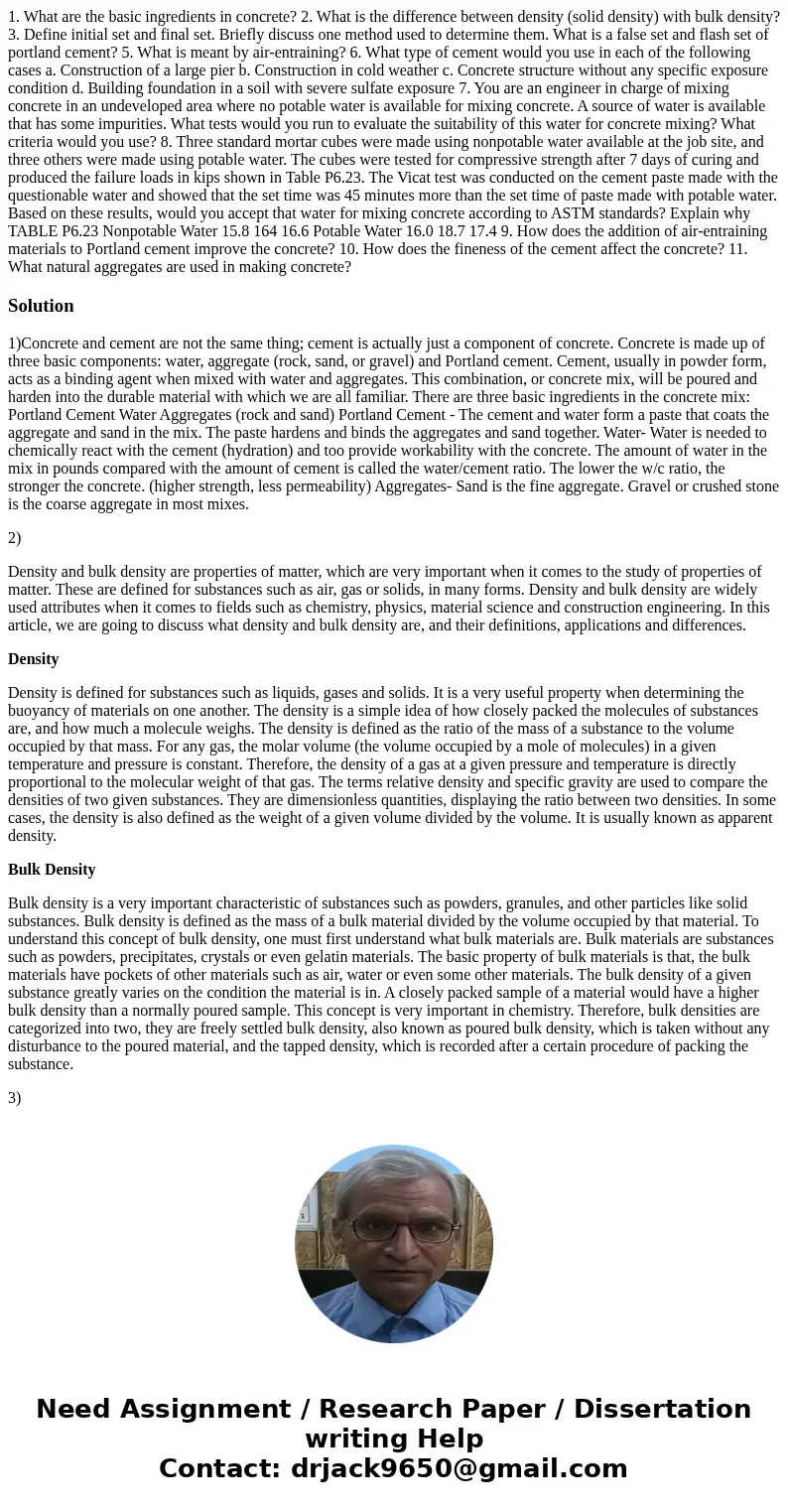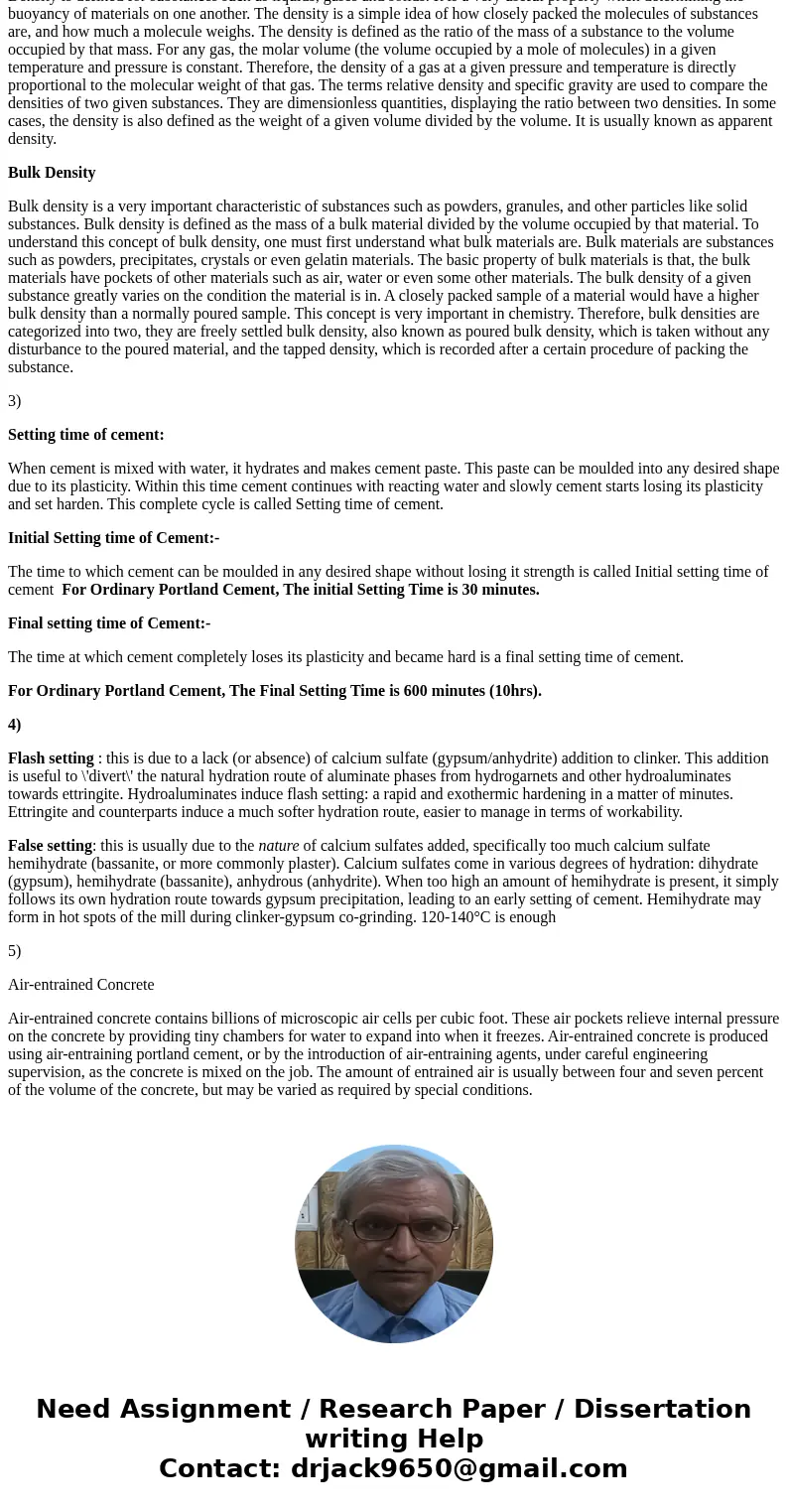1 What are the basic ingredients in concrete 2 What is the d
Solution
1)Concrete and cement are not the same thing; cement is actually just a component of concrete. Concrete is made up of three basic components: water, aggregate (rock, sand, or gravel) and Portland cement. Cement, usually in powder form, acts as a binding agent when mixed with water and aggregates. This combination, or concrete mix, will be poured and harden into the durable material with which we are all familiar. There are three basic ingredients in the concrete mix: Portland Cement Water Aggregates (rock and sand) Portland Cement - The cement and water form a paste that coats the aggregate and sand in the mix. The paste hardens and binds the aggregates and sand together. Water- Water is needed to chemically react with the cement (hydration) and too provide workability with the concrete. The amount of water in the mix in pounds compared with the amount of cement is called the water/cement ratio. The lower the w/c ratio, the stronger the concrete. (higher strength, less permeability) Aggregates- Sand is the fine aggregate. Gravel or crushed stone is the coarse aggregate in most mixes.
2)
Density and bulk density are properties of matter, which are very important when it comes to the study of properties of matter. These are defined for substances such as air, gas or solids, in many forms. Density and bulk density are widely used attributes when it comes to fields such as chemistry, physics, material science and construction engineering. In this article, we are going to discuss what density and bulk density are, and their definitions, applications and differences.
Density
Density is defined for substances such as liquids, gases and solids. It is a very useful property when determining the buoyancy of materials on one another. The density is a simple idea of how closely packed the molecules of substances are, and how much a molecule weighs. The density is defined as the ratio of the mass of a substance to the volume occupied by that mass. For any gas, the molar volume (the volume occupied by a mole of molecules) in a given temperature and pressure is constant. Therefore, the density of a gas at a given pressure and temperature is directly proportional to the molecular weight of that gas. The terms relative density and specific gravity are used to compare the densities of two given substances. They are dimensionless quantities, displaying the ratio between two densities. In some cases, the density is also defined as the weight of a given volume divided by the volume. It is usually known as apparent density.
Bulk Density
Bulk density is a very important characteristic of substances such as powders, granules, and other particles like solid substances. Bulk density is defined as the mass of a bulk material divided by the volume occupied by that material. To understand this concept of bulk density, one must first understand what bulk materials are. Bulk materials are substances such as powders, precipitates, crystals or even gelatin materials. The basic property of bulk materials is that, the bulk materials have pockets of other materials such as air, water or even some other materials. The bulk density of a given substance greatly varies on the condition the material is in. A closely packed sample of a material would have a higher bulk density than a normally poured sample. This concept is very important in chemistry. Therefore, bulk densities are categorized into two, they are freely settled bulk density, also known as poured bulk density, which is taken without any disturbance to the poured material, and the tapped density, which is recorded after a certain procedure of packing the substance.
3)
Setting time of cement:
When cement is mixed with water, it hydrates and makes cement paste. This paste can be moulded into any desired shape due to its plasticity. Within this time cement continues with reacting water and slowly cement starts losing its plasticity and set harden. This complete cycle is called Setting time of cement.
Initial Setting time of Cement:-
The time to which cement can be moulded in any desired shape without losing it strength is called Initial setting time of cement For Ordinary Portland Cement, The initial Setting Time is 30 minutes.
Final setting time of Cement:-
The time at which cement completely loses its plasticity and became hard is a final setting time of cement.
For Ordinary Portland Cement, The Final Setting Time is 600 minutes (10hrs).
4)
Flash setting : this is due to a lack (or absence) of calcium sulfate (gypsum/anhydrite) addition to clinker. This addition is useful to \'divert\' the natural hydration route of aluminate phases from hydrogarnets and other hydroaluminates towards ettringite. Hydroaluminates induce flash setting: a rapid and exothermic hardening in a matter of minutes. Ettringite and counterparts induce a much softer hydration route, easier to manage in terms of workability.
False setting: this is usually due to the nature of calcium sulfates added, specifically too much calcium sulfate hemihydrate (bassanite, or more commonly plaster). Calcium sulfates come in various degrees of hydration: dihydrate (gypsum), hemihydrate (bassanite), anhydrous (anhydrite). When too high an amount of hemihydrate is present, it simply follows its own hydration route towards gypsum precipitation, leading to an early setting of cement. Hemihydrate may form in hot spots of the mill during clinker-gypsum co-grinding. 120-140°C is enough
5)
Air-entrained Concrete
Air-entrained concrete contains billions of microscopic air cells per cubic foot. These air pockets relieve internal pressure on the concrete by providing tiny chambers for water to expand into when it freezes. Air-entrained concrete is produced using air-entraining portland cement, or by the introduction of air-entraining agents, under careful engineering supervision, as the concrete is mixed on the job. The amount of entrained air is usually between four and seven percent of the volume of the concrete, but may be varied as required by special conditions.


 Homework Sourse
Homework Sourse